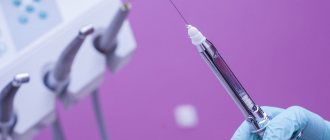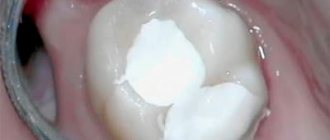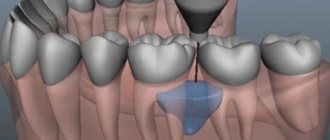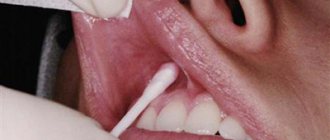05.12.2019
A huge number of people are afraid to visit dentists because dental treatment is usually accompanied by pain and other unpleasant sensations. There is even a special term - dentophobia - fear of dentists, which, according to some data, can describe 84% of patients. However, nowadays, anesthesia comes to the aid of dental phobes, facilitating a calm dental procedure.
But people are usually concerned about how long the freezing effect lasts and how to quickly recover from dental anesthesia, because it can interfere with eating or distort your smile.
Classification of anesthesia in dentistry
Anesthesia, or anesthesia, in dentistry has a certain classification. Various drugs and their types are used in individual cases, depending on the time required by the doctor for the operation, the patient’s condition, and the presence of severe fear or phobia. First of all, anesthesia is divided into two types:
- general anesthesia, or anesthesia;
- local anesthesia.
Anesthesia is usually used only in isolated cases of necessity, if the operation is expected to be very long. So, general anesthesia can last about six hours. Moreover, it has a number of advantages relative to local anesthesia:
- you can remove several teeth or perform several procedures in one go;
- Treatment under general anesthesia is completely painless;
- During anesthesia, the secretion of saliva is blocked, which is very beneficial to the doctor.
However, in most cases there is simply no need for anesthesia, so local anesthesia is used, which is often popularly called tooth freezing.
Features of local anesthesia
Local anesthesia is simple and in most cases can satisfy the need for pain relief, which is why it is especially popular among dentists. In turn, tooth freezing is divided into the following types:
Application anesthesia
It is carried out using gels or sprays that are applied to the gum or cheek. The effect can be observed approximately five minutes after application. However, topical anesthesia is used only in cases where it is necessary to get rid of tartar, remove a falling out or loose tooth, treat gums, or carry out another practically painless procedure, because the spray or gel freezes only the surface of the mucous membrane.
Moreover, topical anesthesia cannot be used for children under five years of age, as well as people with lung diseases.
Infiltration anesthesia, or injection
This type of anesthesia is performed by injecting an anesthetic into the soft tissue located near the diseased tooth to freeze it. It affects the deep layers of tissue. The injection is administered near the location of the entrance of the nerve trunks leading to half of the jaw or its separate part. Usually, not only the cheek and the necessary gums are frozen, but also other organs of the oral cavity, since the exits of all nerves are located close to each other.
It is also important to understand that freezing the upper and lower jaws are somewhat different in their methodology and action due to differences in the structure of the skeleton. Considering that the lower jaw usually has greater loads relative to the upper jaw, evolutionarily it has developed that it has a more dense structure and its muscles are more developed.
Therefore, when injecting an anesthetic into the lower jaw, the needle is inserted deeper, which also affects the duration of the anesthetic.
What you need to know about anesthesia for dental treatment
10-30% of people do not go to the dentist because of pain. Delaying treatment makes the problem worse. Pain management helps patients feel comfortable during dental procedures.
Types of dental anesthetics
Anesthesia means absence or loss of sensation. With light anesthesia, the person is conscious. In severe cases, the patient is put to sleep. The doctor at the Nika Dentistry clinic uses medications separately or in combination. Selects medications for a safe procedure. The type of anesthetic used also depends on the person's age, health, length of the procedure, and previous negative reactions to anesthetics.
Short-term medications are applied directly to the tooth area. Long-acting is used when complex jaw surgery is performed.
The success of dental anesthesia depends on:
- drug;
- areas of anesthesia administration;
- type of procedure;
- time of the operation;
- severity of inflammation.
Local anesthesia in the lower jaw is not as strong as in the upper jaw.
Doctors give three types of anesthesia: local, sedative and general. The choice depends on the location of the manipulation, the severity of the problem and the combination with other medications.
Local anesthesia
Local anesthesia is used for simple procedures such as tooth filling, which require a short time to complete and are less complex. The person is conscious and talking when local anesthesia is given. The area is numb so that the patient does not feel pain. A popular local anesthetic is lidocaine.
Local anesthetics will numb the pain within 10 minutes, and the best anesthesia for dental treatment wears off between 30 and 60 minutes. Sometimes a vasopressor such as epinephrine is added to enhance the effect and prevent the anesthetic effect from spreading to other parts of the body.
Local anesthetics are available in the form of gel, ointment, cream, spray, patch, liquid and ampoules. Use topically (apply directly to the area to numb it) or inject into the area being treated.
Sometimes sedatives are added to anesthetics to help you relax. The patient remains fully conscious and responds to commands after slight sedation. If the drug is moderate, the person is semi-conscious or almost unconscious if the sedation is deep.
Sedatives are administered orally (tablet or liquid), inhaler, intramuscularly, or intravenously. During moderate to deep sedation, the doctor monitors your heart rate, blood pressure, and breathing.
General anesthesia
General anesthesia is used for long procedures or when the client is nervous and interferes with treatment. The person is unconscious, does not feel pain, the muscles are relaxed, and does not remember how the operation took place. The medicine is administered by putting a mask on the face or intravenously. The dose depends on the procedure and the patient's condition.
What are the side effects
The side effects of dental anesthesia depend on the type of anesthetic used. General anesthesia has more risks than local anesthesia. Reactions also vary:
- nausea or vomiting;
- headache;
- sweating or shaking;
- hallucinations, delusions, or confusion;
- slurred speech;
- dry mouth or throat;
- pain at the injection site;
- dizziness;
- fatigue;
- numbness;
- trismus caused by trauma from surgery.
Vasoconstrictors such as epinephrine added to anesthetics also cause heart and blood pressure problems. These are some side effects of anesthetics. Ask your dentist about the medicine and any problems that may arise after use.
Precautions when prescribing
A person gives consent to treatment before sitting in the dentist's chair. Ask your doctor questions about the risks and precautions to take for a positive outcome.
Pregnancy
The dentist or surgeon will discuss the risks and benefits of anesthetics for the expectant mother and fetus.
Special Needs
For children and people with special needs, the type and dose of anesthetic is adjusted to avoid adverse reactions or overdose.
Aged people
Seniors with health problems will require dosage adjustments and monitoring during and after surgery. Some people become delirious or experience confusion and memory problems after surgery.
Liver, kidney, lung, or heart problems
People with liver, kidney, lung, or heart disease require a dose adjustment because the medicine will take longer to leave the body or will have a strong effect.
Neurological diseases
If you have a history of stroke, Alzheimer's disease, Parkinson's disease, thyroid disease or mental illness, the risk of general anesthesia is increased.
Other conditions
Tell your dentist if you have a hiatal hernia, acid reflux, infections or open sores in your mouth, allergies, severe nausea and vomiting, or are taking medications that cause drowsiness.
The risks are higher for those who:
- sleep apnea;
- epilepsy;
- obesity;
- hypertension;
- heart problems;
- attention or behavior disorder;
- chronic obstructive pulmonary disease;
- gastric bypass;
- Substance abuse.
What are the risks of dental anesthesia
Most people do not experience adverse reactions with local anesthesia. There is a higher risk with general anesthesia, especially in older people and people with medical complications. There is an increased risk of abnormal bleeding while taking blood thinning medications such as aspirin. If you are taking painkillers or nerve medications, tell your dentist or surgeon so they can select an anesthetic.
Anesthesia risks:
- seizures;
- coma;
- respiratory arrest;
- heart failure;
- heart attack;
- stroke;
- hypotension;
- hyperthermia;
- muscle stiffness;
- breathing problems;
- tachycardia.
Allergic reaction
Tell your dentist about any allergies, including reactions to dyes or other substances: rash, itching, swelling of the tongue, lips, mouth, or throat, and difficulty breathing; The anesthetics articaine and prilocaine at a concentration of 4% damage nerves and cause paresthesia;
Conclusion
Discuss concerns about the procedure with your dentist. Ask questions about medications used for pain and what to expect during and after treatment. Get a medical history from your physician, including information about allergies and other medications you take, including over-the-counter and prescription medications and dietary supplements.
Ask for instructions on how to behave before and after, including eating and drinking before and after oral procedures. Ask if transportation home needs to be arranged and see if all questions have been asked of the dentist. The dentist will provide instructions to follow before and after the procedure, and will provide a phone number to contact them in case of complications or questions.
Duration of action of the anesthetic
A huge number of patients are usually interested in how quickly tooth frost will go away, but it is necessary to understand that the duration of action of the anesthetic depends not only on the type of anesthesia, the area of its application, dosage, the person’s age, metabolic rate and other individual parameters, but also on the painkiller used facilities. Thus, dental anesthetics can be divided into three groups according to the duration of their effect:
- short-acting (Novocaine) – up to twenty minutes;
- medium-acting (Prilocaine, Articaine, Trimecaine, Lidocaine) - from half an hour to an hour;
- long-acting (Bupivacaine) - the effect in some cases can last up to six hours, but usually a sensitivity-blocking dosage is used for two hours.
However, as mentioned above, there are a number of factors that influence the duration of action of the painkiller:
- the presence of inflammation at the site of drug administration;
- the presence of vasoconstrictors in the composition of the anesthetic - substances that narrow blood vessels;
- injection depth;
- site of drug administration;
- chronic diseases of the urinary system;
- individual parameters of the human body.
But in most cases, drugs when injected into the upper jaw last for the next two hours, and when injected into the lower jaw - up to four. However, again, this all depends on the freezing method and many other factors, so if the anesthesia persists for a longer period of time, there is no cause for concern.
Only if freezing remains relevant even after 24 hours should you consult your doctor.
Reasons why anesthesia does not take effect
A patient comes to me and says that anesthesia does not work on him and that the last time he had a tooth removed under anesthesia. And now we are supposed to work on tooth extraction. I honestly say that he may well go to the previous clinic, where he had general anesthesia, because... I don’t know the real reasons why the anesthetic didn’t work and why the doctors then switched to general anesthesia. Then the patient decided to remove the tooth from me without general anesthesia, with ordinary anesthesia. And it turned out that the anesthesia worked great and we removed the tooth painlessly.
I want to tell you in what cases anesthesia does not work. You can understand this, you can prepare for it and make sure everything goes well.
- It is not recommended to drink any alcohol in any quantity within 24 hours. Because the anesthesia will not work. How it works? The anesthetic reduces pain sensitivity by acting on the nerve endings going to the tooth. Alcohol also affects the nerves - it relaxes. And, in particular, it relaxes those small branches of nerves that innervate the teeth. And therefore, if you drink a glass of wine or a glass of beer, the nerves from the tooth will also be “relaxed” for about 24 hours: until the alcohol is transformed in the kidneys and liver and is eliminated from the body naturally. Usually, during anesthesia, pain sensitivity goes away immediately, that is, the anesthetic solution is perceived normally by the nerve fiber. And if it doesn’t work, one of the possible reasons is that there was alcohol in the blood, and it could even be one glass of wine!
- When there is a lot of swelling and inflammation inside. Inflammation is an acidic environment, the pH of which inactivates the injected anesthetic solution immediately. Those. the injected anesthetic solution, entering a place next to the tooth, cannot act on the nerve endings, because there is an acidic inflammatory environment there. When does this happen? When a visit to the dentist is postponed until the last minute, to such a state that it becomes more and more difficult to help.
- When your own adrenaline goes off scale from fear and general tension in the body, when the muscles of the neck, shoulder blades, back of the head, and upper shoulder girdle are so tense that the blood simply does not circulate due to tightness and muscle tension. All this does not help the anesthesia work; the substance simply does not reach the recipient. You need to take three deep, slow breaths, relax, relieve muscle tension in your shoulders and try not to concentrate on your images of fear, but to think about the good.
- Good anesthetics of the latest generation are effective. I use Ultracain DS forte in different dosages. I consider other, cheaper anesthetics not very effective. Although many doctors say that they are the same as Ultracain DS forte only one and a half times cheaper. I believe that you cannot skimp on anesthesia. It must be a priori good. No options. Good pain relief means job success and patient peace of mind.
Method for reducing the effect of anesthesia
Usually, even after an operation or a procedure requiring anesthesia, the painkiller continues to make itself felt: the lips remain numb, it is not possible to eat normally, the smile becomes distorted. Therefore, people are looking for a way to help the anesthetic stop working as quickly as possible.
In this case, dentists usually recommend applying warm compresses to the cheek. This will help dilate the blood vessels, which will ultimately increase the metabolic rate and remove the anesthetic from the body. However, this is contraindicated after tooth extraction or if inflammation remains. Thus, it is strictly forbidden to heat a tooth or cheek during gumboil. Therefore, it is highly recommended that you consult your dentist initially.
Types of anesthetics and their features
Exactly how long anesthesia lasts after dental treatment depends on what type of anesthesia is used.
The following types of anesthesia are used in modern dentistry:
- Applique. The main feature is a short period of action. It is a gel or spray for surface use. Use is limited to a small number of procedures that do not require significant anesthesia for a long period. These drugs can be used as auxiliary drugs.
- Infiltration. Such anesthesia must be injected with a syringe into the area of bone tissue or periosteum. It is used for many procedures, including cleaning dental canals. Valid for an hour.
- Conductor. The product acts directly on the trigeminal nerve area. The injection may cause severe pain, which can be relieved with another anesthesia. Used to treat molars.
- Intraligamentary. It is aimed at a specific tooth for various procedures - chipping occurs around the diseased incisor. Used for tooth extraction or complex operations.
Articaine series
Articaine is a common painkiller used throughout the world. It is available in various forms and dosages, which allows you to choose the optimal anesthetic for the patient. It can be combined with medications of the adrenaline group, which allows you to narrow blood vessels and prevent possible blood loss.
This anesthetic is stronger in effect than traditional painkillers: five to six times than lidocaine and two to three times than novocaine. Anesthesia can be performed in such a way that it will not harm either patients with contraindications or pregnant and lactating women.
The duration of tooth freezing can be selected so that the anesthesia after tooth treatment begins to wear off immediately after the end of the intervention and does not cause discomfort.
Mepivacaines
This is a special group of anesthetics that does not require combination with adrenaline. Due to this, it is less effective. But thanks to its formula, it can be prescribed for the treatment of pregnant women, patients with cardiovascular diseases and is used to treat children.
It is used in dentistry not only during treatment and procedures, but also to reduce pain after their completion, for example, as painkillers after wisdom tooth removal. The use of the drug allows you to painlessly treat severe cases of dental diseases.
It has contraindications, so before use a sensitivity test is required, which will determine how long the effect will take and how the patient will tolerate anesthesia.
Anesthesia during pregnancy
Typically, dentists recommend treating teeth and gums while planning pregnancy, because anesthetics can indirectly affect the intrauterine development of the fetus. However, if necessary, it is better to go to the doctor in the second trimester of pregnancy, but if there is an urgent need for treatment, then it can be performed at any stage.
The most modern painkillers, which do not contain adrenaline, are used for pregnant women to avoid the possibility of increased blood pressure and contractions of the uterus. Usually, drugs with minimal toxic effects on the body are also used.
In some cases, pregnant women are transferred to a hospital for treatment.
Thus, all necessary procedures can be carried out under the strict supervision of the attending physician to avoid any complications.
Tooth freezing while breastfeeding
Some mothers are afraid to visit dentists while breastfeeding, thinking that anesthetics through milk can have a negative effect on their children. However, there is practically no reason for this.
Neither the anesthetic itself nor the accompanying possible toxic substances are reflected in the milk, because they act only on a certain area of the jaw and are not introduced into the blood.
But in order to further reduce the likelihood of negative effects of drugs on babies, dentists recommend feeding them before visiting the doctor, and also preparing in advance the required amount of milk for the next feeding of the baby. Thus, the toxic substance will not have the opportunity to enter the child’s body.
Category Miscellaneous Published by Mister dentist









